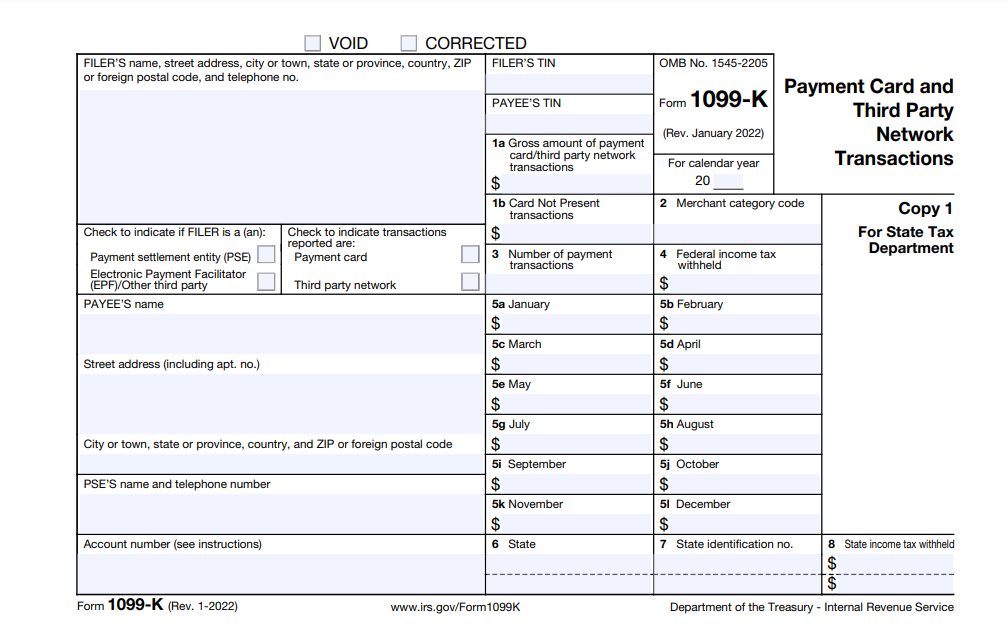Form 1099-K, a tax document, details payments exceeding $20,000 or 200 transactions from payment processors like credit card companies or online platforms in a year. Even non-business individuals can receive it for various reasons. Did you sell personal items online? You can get it if you receive gifts or reimbursements through apps like PayPal or Venmo. Even using services like Uber or Airbnb might trigger it.
What do you do with this form? The key is understanding it. Check the details, spot payment sources, and grasp the transaction nature. Your goal? Reporting income accurately on your tax return. Whether you sell your old furniture on an online marketplace or chip in on an Uber ride, it matters.
Identify your income sources—perhaps revenue from the sales of that vintage lamp or reimbursement from a friend? Then, report it right on your tax return. It’s a way to ensure everything aligns with the IRS guidelines.
- What Form 1099-K Is
- Review the Information on Form 1099-K
- Identify the Source and Nature of the Payments
- Report Your Income and Expenses on Your Tax Return
Recap
1. What Form 1099-K Is

Form 1099-K is a tax document that tells the IRS about payments you get from companies that handle your transactions, like credit card firms or online platforms. You probably get one if you make over $20,000 and have more than 200 transactions in a year.
Now, you might be wondering why you would get this if you are not running a business. Well, here’s the deal:
If you clean out your closet and sell some stuff online (like clothes or books) on an auction site or a marketplace, you get a 1099-K. Even if you’re just getting payments back from friends or family through apps like PayPal or Venmo, or if you use apps to pay for things like rides, stays, or handmade crafts on platforms like Uber, Airbnb, or Etsy, you still find a 1099-K in your mailbox.
So, it’s not just for business owners; regular people making transactions online receive Form 1099-K too. If you’re hitting high payment thresholds, the IRS wants to know about it. Just keep an eye out for that form—it’s tax time’s way of requesting information about the transactions you make in a year.
>>>MORE: Form 945: What It Is, How to File It
2. Review the Information on Form 1099-K
To understand Form 1099-K, break down the key details in each box.
This form contains important details about your payments; it reveals only the last four digits of your Individual Tax Identification Number (ITIN), Social Security Number (SSN), or other private identification numbers to safeguard your privacy. Despite this, the issuer submits your complete TIN to the IRS. The document also features your account number from the Payment Settlement Entity (PSE) for identification purposes.
In Box 1a, you see your total amount from payment card or third-party network transactions throughout the year. Meanwhile, Box 1b outlines the aggregate gross amount from transactions where your card is not physically present, like online or phone sales. Box 2 indicates the merchant category code for your transactions, if it is readily available.
Other critical information includes Box 3, revealing the number of payment transactions that the payment card processes, and Box 4, Federal Income Tax which applies if you do not provide your TIN. Monthly transaction details are in Boxes 5a-5l, while Boxes 6-8 show state and local income tax withholdings.
Verify details like the payer’s name, address, and tax ID, along with the payment amounts on the report, to ensure accuracy. If you spot errors on the form, promptly contact the payer (FILER or PSE) and request a correct form. Keep copies of both the original and correct forms for your records.
Staying on top of these details is very important, so don’t hesitate to reach out to the payer if necessary. This ensures the accuracy of your financial records and compliance with tax regulations. Taking a proactive approach to address any discrepancies is key to maintaining precise and reliable documentation.
3. Identify the Source and Nature of the Payments
When it comes to Form 1099-K, the tax on your payments depends on the source and nature. If you receive income from your business activities, like selling items online or renting a property through a platform, it’s taxable, and you report it on Schedule C or E of your tax return. Crowdfunding earnings, excluding donations, also fall into this category.
However, some payments are non-taxable. If you sell personal items at a loss or receive gifts or reimbursements from friends and family, these aren’t taxable income. But be aware of gift reporting requirements for amounts exceeding the annual exclusion.
Payments for qualified charitable contributions are not taxable income but may be deductible if you itemize on Schedule A.
Keeping records of transactions, such as receipts and invoices, is crucial. These records support your income and expense reporting, helping you verify Form 1099-K accuracy. Stay organized, understand the source of your payments, and report your income correctly to sail through tax season smoothly.
4. Report Your Income and Expenses on Your Tax Return
To report your taxable income from Form 1099-K on Schedule C of your federal Form 1040, follow these simple steps.
First, fill in your basic information on Schedule C, including your name, social security number, and business details. Next, list your gross income, which you receive from Form 1099-Ks on Schedule C, line 1, under Gross receipts or sales.
Moving on to allowable expenses, report them on Schedule C, lines 8 to 27. Deduct ordinary and necessary expenses in connection with your trade or business, like fees, shipping costs, or advertising. Keep records in detail for accurate reporting.
Subtract your total expenses from your gross income, and note the result on Schedule C, line 31, as your net profit or loss. This figure goes to Form 1040, line 13, under business income or loss.
For non-taxable income, such as that from Form 1099-K, report it on Form 1040, line 8, additional income. Write “Form 1099-K” on the line it provides to specify the source of this income.
It’s crucial to report your income and expenses accurately to avoid penalties. If you’re uncertain, seek guidance from a tax professional or use reliable online tax software. Stay honest and pay your taxes promptly to comply with IRS regulations.
>>>GET SMARTER: Form 5498-ESA: What It Is, How to File It
Recap
Form 1099-K isn’t just for businesses; you can get it if you carry out over 200 deals or online transactions over $20,000 annually. It covers everything from selling stuff online to splitting an Uber ride.
To understand it better, break the form down, double-check details, and fix errors immediately.
It is important to identify your income source – business-related or non-taxable gifts and reimbursements. So, you have to keep solid records.
When reporting transactions on your tax return as a follow-up on your Form 1099-K which you receive, Schedule C handles taxable income, and Form 1040, line 8, covers the non-taxable part. Stay organized, be honest, and seek help when you need to.
This post is to be used for informational purposes only and does not constitute legal, business, or tax advice. Each person should consult his or her own attorney, business advisor, or tax advisor with respect to matters referenced in this post. . For comprehensive tax, legal or financial advice, always contact a qualified professional in your area. S’witty Kiwi assumes no liability for actions taken in reliance upon the information contained herein.








No Comment! Be the first one.